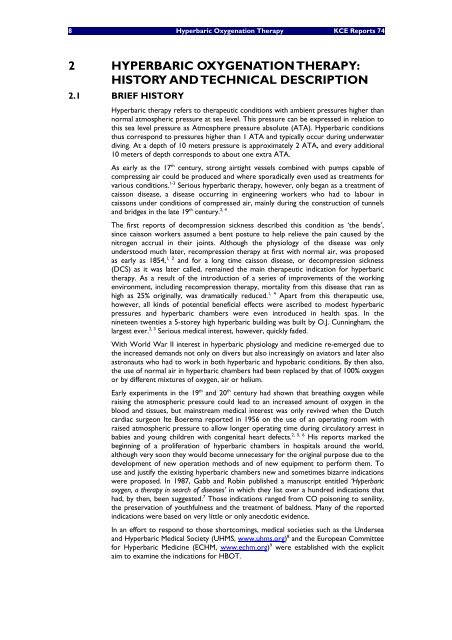Download the full report (130 p.)
Download the full report (130 p.)
Download the full report (130 p.)
Create successful ePaper yourself
Turn your PDF publications into a flip-book with our unique Google optimized e-Paper software.
8 Hyperbaric Oxygenation Therapy KCE Reports 74<br />
2 HYPERBARIC OXYGENATION THERAPY:<br />
HISTORY AND TECHNICAL DESCRIPTION<br />
2.1 BRIEF HISTORY<br />
Hyperbaric <strong>the</strong>rapy refers to <strong>the</strong>rapeutic conditions with ambient pressures higher than<br />
normal atmospheric pressure at sea level. This pressure can be expressed in relation to<br />
this sea level pressure as Atmosphere pressure absolute (ATA). Hyperbaric conditions<br />
thus correspond to pressures higher than 1 ATA and typically occur during underwater<br />
diving. At a depth of 10 meters pressure is approximately 2 ATA, and every additional<br />
10 meters of depth corresponds to about one extra ATA.<br />
As early as <strong>the</strong> 17 th century, strong airtight vessels combined with pumps capable of<br />
compressing air could be produced and where sporadically even used as treatments for<br />
various conditions. 1-3 Serious hyperbaric <strong>the</strong>rapy, however, only began as a treatment of<br />
caisson disease, a disease occurring in engineering workers who had to labour in<br />
caissons under conditions of compressed air, mainly during <strong>the</strong> construction of tunnels<br />
and bridges in <strong>the</strong> late 19 th 2, 4<br />
century.<br />
The first <strong>report</strong>s of decompression sickness described this condition as ‘<strong>the</strong> bends’,<br />
since caisson workers assumed a bent posture to help relieve <strong>the</strong> pain caused by <strong>the</strong><br />
nitrogen accrual in <strong>the</strong>ir joints. Although <strong>the</strong> physiology of <strong>the</strong> disease was only<br />
understood much later, recompression <strong>the</strong>rapy at first with normal air, was proposed<br />
as early as 1854, 1, 2 and for a long time caisson disease, or decompression sickness<br />
(DCS) as it was later called, remained <strong>the</strong> main <strong>the</strong>rapeutic indication for hyperbaric<br />
<strong>the</strong>rapy. As a result of <strong>the</strong> introduction of a series of improvements of <strong>the</strong> working<br />
environment, including recompression <strong>the</strong>rapy, mortality from this disease that ran as<br />
high as 25% originally, was dramatically reduced. 1, 4 Apart from this <strong>the</strong>rapeutic use,<br />
however, all kinds of potential beneficial effects were ascribed to modest hyperbaric<br />
pressures and hyperbaric chambers were even introduced in health spas. In <strong>the</strong><br />
nineteen twenties a 5-storey high hyperbaric building was built by O.J. Cunningham, <strong>the</strong><br />
largest ever. 2, 3 Serious medical interest, however, quickly faded.<br />
With World War II interest in hyperbaric physiology and medicine re-emerged due to<br />
<strong>the</strong> increased demands not only on divers but also increasingly on aviators and later also<br />
astronauts who had to work in both hyperbaric and hypobaric conditions. By <strong>the</strong>n also,<br />
<strong>the</strong> use of normal air in hyperbaric chambers had been replaced by that of 100% oxygen<br />
or by different mixtures of oxygen, air or helium.<br />
Early experiments in <strong>the</strong> 19 th and 20 th century had shown that breathing oxygen while<br />
raising <strong>the</strong> atmospheric pressure could lead to an increased amount of oxygen in <strong>the</strong><br />
blood and tissues, but mainstream medical interest was only revived when <strong>the</strong> Dutch<br />
cardiac surgeon Ite Boerema <strong>report</strong>ed in 1956 on <strong>the</strong> use of an operating room with<br />
raised atmospheric pressure to allow longer operating time during circulatory arrest in<br />
babies and young children with congenital heart defects. 2, 5, 6 His <strong>report</strong>s marked <strong>the</strong><br />
beginning of a proliferation of hyperbaric chambers in hospitals around <strong>the</strong> world,<br />
although very soon <strong>the</strong>y would become unnecessary for <strong>the</strong> original purpose due to <strong>the</strong><br />
development of new operation methods and of new equipment to perform <strong>the</strong>m. To<br />
use and justify <strong>the</strong> existing hyperbaric chambers new and sometimes bizarre indications<br />
were proposed. In 1987, Gabb and Robin published a manuscript entitled ‘Hyperbaric<br />
oxygen, a <strong>the</strong>rapy in search of diseases’ in which <strong>the</strong>y list over a hundred indications that<br />
had, by <strong>the</strong>n, been suggested. 7 Those indications ranged from CO poisoning to senility,<br />
<strong>the</strong> preservation of youthfulness and <strong>the</strong> treatment of baldness. Many of <strong>the</strong> <strong>report</strong>ed<br />
indications were based on very little or only anecdotic evidence.<br />
In an effort to respond to those shortcomings, medical societies such as <strong>the</strong> Undersea<br />
and Hyperbaric Medical Society (UHMS, www.uhms.org) 8 and <strong>the</strong> European Committee<br />
for Hyperbaric Medicine (ECHM, www.echm.org) 9 were established with <strong>the</strong> explicit<br />
aim to examine <strong>the</strong> indications for HBOT.

















